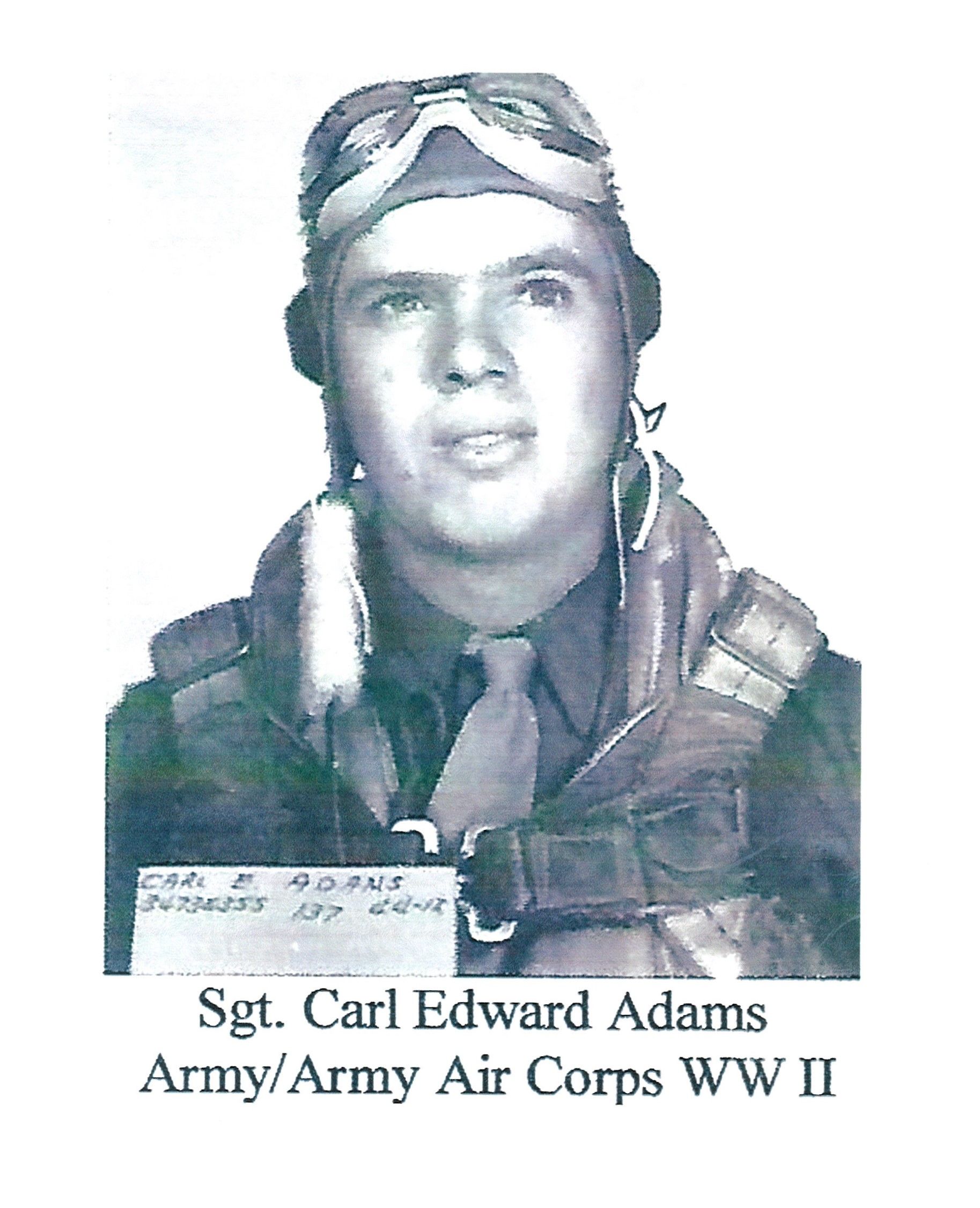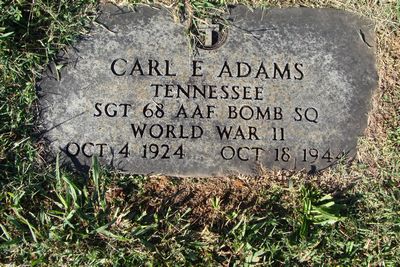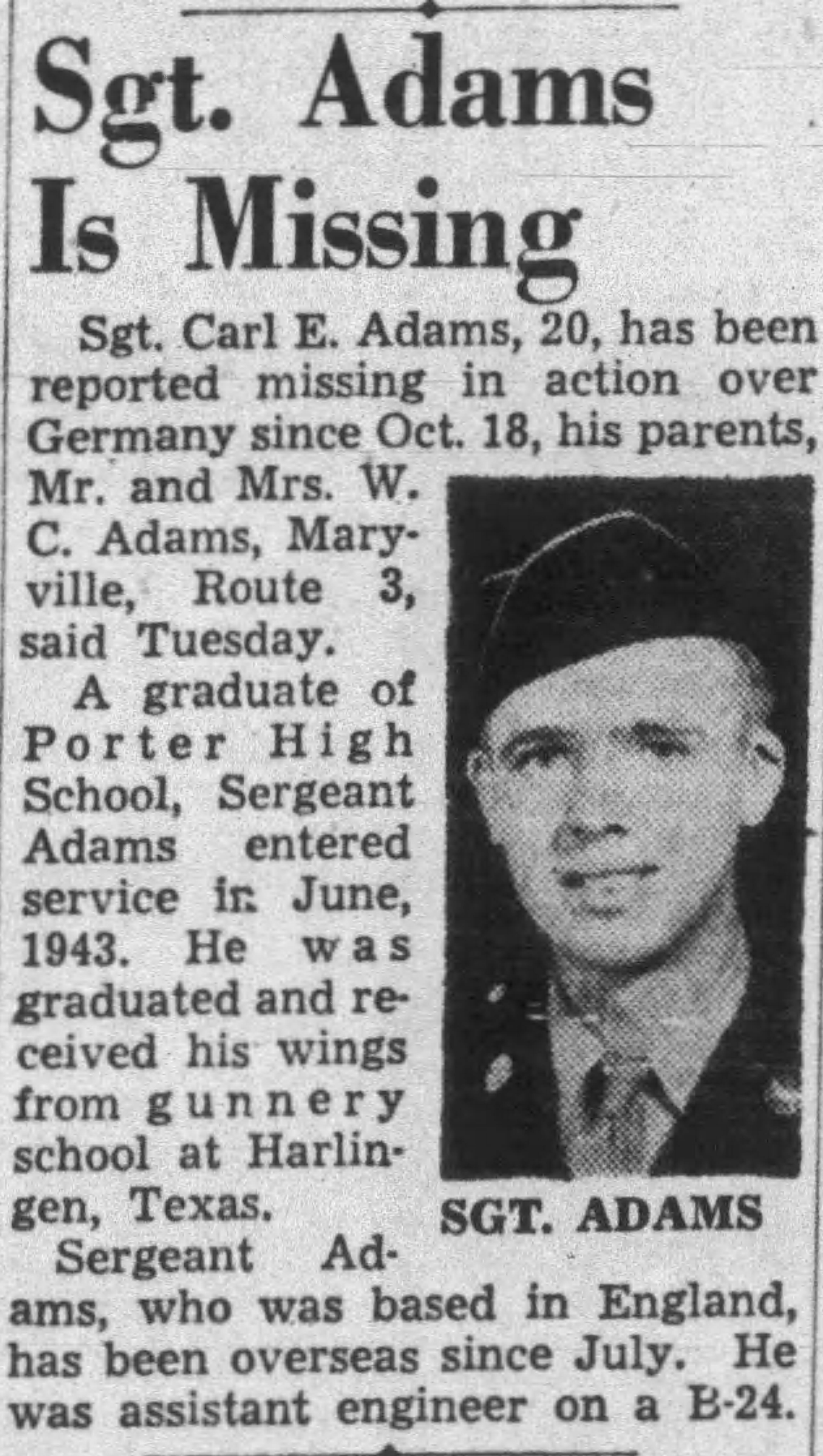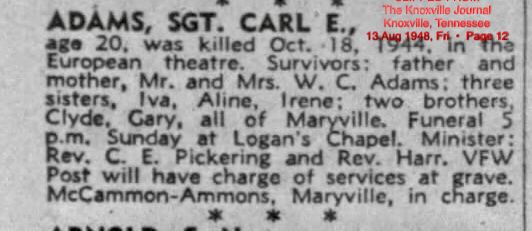----------------------------------------------------------
USAAF WORLD WAR II
Gunner Sgt. Carl E. Adams KIA
Hometown: Maryville, Tennessee
Squadron: 68th 44th Bomb Group
Service# 34735355
Awards: Awards: Air Medal, Purple Heart
Pilot 1st/Lt. Edward C. Lehnhausen KIA
MACR #9654
Target: Leverkusen, Germany
Mission Date: 18-Oct-44
Serial Number: #42-50596
Aircraft Model B-24
Aircraft Letter: O
Aircraft Name: FLAK MAGNET
Location: near Middelburg on Zeeland of Welcherin Zuid
Cause: Flak
Crew of 9 KIA
Note: The Group sent 31 aircraft to attack the Chemical Works located at Leverkusen. Bombing was accomplished with G-H equipment; results unobserved due to clouds. Three aircraft did not return, due primarily to the severe weather conditions that existed over the continent. Squadrons incurring losses were the 67th and 68th.
With no MACR available and little or no information in either the reporting of the 68th Squadron or the 44th Headquarters, it has taken many years to discover any data about the loss of this aircraft and crew. This mission planning as briefed changed as soon as the Lead plane, E-806, piloted by Parks failed to take off. Colonel Turnbull transferred to D-944, piloted by Captain Bakalo and they led the formation. 1st Lt. Edward Lehnhausen, in O-596, had been shown to be in the last section, and on the right, behind Lt. Kelly. Also, there were several other aircraft that aborted, so the briefed positions were considerably changed.
Robert Lehnhausen, brother of Edward, told me that, "The 44th Bomb Group filled in a formation with another Group. It was three 'boxes' and the fourth squadron filled in. Edward was in the high, right section and Lt. Dayball was in the low left. Edward was on Lt. Kelly's wing and had a poor navigator who was on his 10th mission.
"When the formation approached that high weather front, they separated to avoid collisions. When Bakalo's aircraft turned over and went down, it is believed it crashed into Dayball's. But it is believed that Lehnhausen's ship became separated from all the others and was flying alone near Walcheren Island, just off the Netherlands coastline when they reached the North Sea. The crewmembers were temporarily buried at various, rather scattered cemeteries. Bob Dimpfl checked, but learned nothing. Edward was buried in Luxemburg, while another was buried at Aachen – so the crew was scattered but no one knows why."
The casualty report provides the following details: "[At 1330 h.] Flak batteries shot off the tail of the B-24 [B-24J 42-50596, FLAK MAGNET] which crashed near the casemates at Buttinge, 3 kilometers west of Middelburg on Walcheren Island, Holland. On return, the formation broke its integrity near Brussels where a cloud layer, building up to 28,000 ft. was encountered. Byron Davis' body was found in the water near Buttinge. The island of Walcheren was inundated at that time, and only the higher lying parts (mostly centers) of the villages were still dry. The Liberator must have crashed on inundated territory, which may explain the loss of bodies." A witness named Mr. H. W. Bouwman (mayor of Grypskerke) reported: "The plane was heading towards Grypskerke (in a northern direction) then it circled back (south) seemingly looking for a place to land. It was spiraling down, gunning its engines trying to control itself when it suddenly lost control...spinning into the ground. The plane crashed at approximately 1,000 yards south southwest of the town of Buttinge in about five to six feet of water.
"The island where the plane crashed was flooded with water usually having about five feet of water, and at high tide, it would rise to ten feet. Therefore, most of the wreckage and the crewmembers, those who were pinned down, were submerged. During the period in which the water remained from the time of crash to about November or December of 1945, we recovered two American aircorp men who were floating around, near the location of the wreckage (about 600 feet away). One was Byron C. Davis, ASN 34248774, who was later buried in Grypskerke cemetery and the other, Ernest A. Fuxa, ASN 18134853, who was buried in Middleburg cemetery. Both were recovered one or two months after the crash. Davis was later disinterred on 13 September 1945 and Ernest Fuxa about the same time. I believe that they were both reinterred in the Margraten cemetery.
"After the flood was drained from the island, I had a chance to look the wreckage over. I saw the bones of some of the crewmen under the broken parts of the wing and fuselage (which was pretty well covered over with barnacles) and estimated that there were about five or six bodies located in the wreckage. These facts are, to the best of my knowledge, all of the information I can recall about the airplane crash that took place at the above-mentioned time and place."
A Dutch historian who has done considerable research on 8th Air Force losses provided the following information regarding Edward Lehnhausen and crew: A/C 42-50596 WQ Flak Magnet passed over Walcheren Island at about 1330 hours on 18 October 1944. It received a direct hit of flak, lost the complete tail section, and crashed near Buttinge, Netherlands (on that same island). The entire crew was killed. They came down near Middelburg on Zeeland of Welcherin Zuid. The bodies were buried locally, near where they came down. Shortly after the war, teams of investigators came in, exhumed the bodies and moved them to the continent. But these teams did not work together; they took the bodies to various other temporary burial areas on the continent.
Later, when our men (Air Force) went to investigate our lost men, they found the crew in various, widely separated cemeteries. This caused considerable confusion as our investigators could not understand why the men were buried so widely separated. Eventually this puzzle was cleared, but not for some time – years later. Hans Hauterman and John Hey from Holland, who have been investigating this crash, do not believe that the guns on Walcheren Island were responsible for the shooting down of B-24J 42-50596. They also sent an extract of a diary kept by a young Dutchman who wrote the following:
"On 18 October, a four-engined bomber came down. There were thunderstorms in that afternoon and I think it was hit by lightning. It may also be that it had already been hit and damaged over Germany; the guns on Walcheren did not fire then. It was a 'Liberator' and came down from a very high altitude, each time overturning what made a terrific noise. It seemed that it would crash near to me but drifted away and fell near Buttinge."
Hauterman and John Hey also report that Walcheren has the shape of a saucer; with high dunes at the sea sides. The Germans had built extraordinary bunkers and installed heavy guns that protected the access to the mouth of the Scheldt River, which runs from Antwerp to the North Sea. Analyzing the burial details in the Casualty Report, they concluded that Dolan, Davis, and Fuxa were recovered and buried in Grijpskerke and Middelburg in October, December, and April. It has been recorded that Davis' body was floating in the water and it is likely to accept that this was also valid for Dolan and Fuxa. Five crewmembers were recovered by a team of the Quartermaster-General that apparently had been attached to a grave Concentration Unit operating on the U.S. Military Cemetery at Luxembourg-Hamm. This team also recovered exhumed American bodies on other locations in the coastal area of western Holland. Most of the U.S. War Dead in Holland were concentrated into the military cemeteries at Margraten (Holland) and Neuville (Belgium).
FLAK MAGNET Crew
1st/Lt. Edward C. Lehnhausen Pilot KIA
2nd/Lt. Charles Dolan Jr. Co Pilot KIA
2nd/Lt. Leonard Witkin Navigator KIA
S/Sgt.Richard D. Haynam Engineer KIA
S/Sgt. Ernest C. Fuxa Radio Op. KIA
Sgt. Byron C. Davis Gunner KIA
Sgt.William C. Young Jr. Gunner KIA
Sgt. Carl E. Adams Gunner KIA
Sgt. Noah Gunter Gunner KIA
----------------------------------------------------------
USAAF WORLD WAR II
Gunner Sgt. Carl E. Adams KIA
Hometown: Maryville, Tennessee
Squadron: 68th 44th Bomb Group
Service# 34735355
Awards: Awards: Air Medal, Purple Heart
Pilot 1st/Lt. Edward C. Lehnhausen KIA
MACR #9654
Target: Leverkusen, Germany
Mission Date: 18-Oct-44
Serial Number: #42-50596
Aircraft Model B-24
Aircraft Letter: O
Aircraft Name: FLAK MAGNET
Location: near Middelburg on Zeeland of Welcherin Zuid
Cause: Flak
Crew of 9 KIA
Note: The Group sent 31 aircraft to attack the Chemical Works located at Leverkusen. Bombing was accomplished with G-H equipment; results unobserved due to clouds. Three aircraft did not return, due primarily to the severe weather conditions that existed over the continent. Squadrons incurring losses were the 67th and 68th.
With no MACR available and little or no information in either the reporting of the 68th Squadron or the 44th Headquarters, it has taken many years to discover any data about the loss of this aircraft and crew. This mission planning as briefed changed as soon as the Lead plane, E-806, piloted by Parks failed to take off. Colonel Turnbull transferred to D-944, piloted by Captain Bakalo and they led the formation. 1st Lt. Edward Lehnhausen, in O-596, had been shown to be in the last section, and on the right, behind Lt. Kelly. Also, there were several other aircraft that aborted, so the briefed positions were considerably changed.
Robert Lehnhausen, brother of Edward, told me that, "The 44th Bomb Group filled in a formation with another Group. It was three 'boxes' and the fourth squadron filled in. Edward was in the high, right section and Lt. Dayball was in the low left. Edward was on Lt. Kelly's wing and had a poor navigator who was on his 10th mission.
"When the formation approached that high weather front, they separated to avoid collisions. When Bakalo's aircraft turned over and went down, it is believed it crashed into Dayball's. But it is believed that Lehnhausen's ship became separated from all the others and was flying alone near Walcheren Island, just off the Netherlands coastline when they reached the North Sea. The crewmembers were temporarily buried at various, rather scattered cemeteries. Bob Dimpfl checked, but learned nothing. Edward was buried in Luxemburg, while another was buried at Aachen – so the crew was scattered but no one knows why."
The casualty report provides the following details: "[At 1330 h.] Flak batteries shot off the tail of the B-24 [B-24J 42-50596, FLAK MAGNET] which crashed near the casemates at Buttinge, 3 kilometers west of Middelburg on Walcheren Island, Holland. On return, the formation broke its integrity near Brussels where a cloud layer, building up to 28,000 ft. was encountered. Byron Davis' body was found in the water near Buttinge. The island of Walcheren was inundated at that time, and only the higher lying parts (mostly centers) of the villages were still dry. The Liberator must have crashed on inundated territory, which may explain the loss of bodies." A witness named Mr. H. W. Bouwman (mayor of Grypskerke) reported: "The plane was heading towards Grypskerke (in a northern direction) then it circled back (south) seemingly looking for a place to land. It was spiraling down, gunning its engines trying to control itself when it suddenly lost control...spinning into the ground. The plane crashed at approximately 1,000 yards south southwest of the town of Buttinge in about five to six feet of water.
"The island where the plane crashed was flooded with water usually having about five feet of water, and at high tide, it would rise to ten feet. Therefore, most of the wreckage and the crewmembers, those who were pinned down, were submerged. During the period in which the water remained from the time of crash to about November or December of 1945, we recovered two American aircorp men who were floating around, near the location of the wreckage (about 600 feet away). One was Byron C. Davis, ASN 34248774, who was later buried in Grypskerke cemetery and the other, Ernest A. Fuxa, ASN 18134853, who was buried in Middleburg cemetery. Both were recovered one or two months after the crash. Davis was later disinterred on 13 September 1945 and Ernest Fuxa about the same time. I believe that they were both reinterred in the Margraten cemetery.
"After the flood was drained from the island, I had a chance to look the wreckage over. I saw the bones of some of the crewmen under the broken parts of the wing and fuselage (which was pretty well covered over with barnacles) and estimated that there were about five or six bodies located in the wreckage. These facts are, to the best of my knowledge, all of the information I can recall about the airplane crash that took place at the above-mentioned time and place."
A Dutch historian who has done considerable research on 8th Air Force losses provided the following information regarding Edward Lehnhausen and crew: A/C 42-50596 WQ Flak Magnet passed over Walcheren Island at about 1330 hours on 18 October 1944. It received a direct hit of flak, lost the complete tail section, and crashed near Buttinge, Netherlands (on that same island). The entire crew was killed. They came down near Middelburg on Zeeland of Welcherin Zuid. The bodies were buried locally, near where they came down. Shortly after the war, teams of investigators came in, exhumed the bodies and moved them to the continent. But these teams did not work together; they took the bodies to various other temporary burial areas on the continent.
Later, when our men (Air Force) went to investigate our lost men, they found the crew in various, widely separated cemeteries. This caused considerable confusion as our investigators could not understand why the men were buried so widely separated. Eventually this puzzle was cleared, but not for some time – years later. Hans Hauterman and John Hey from Holland, who have been investigating this crash, do not believe that the guns on Walcheren Island were responsible for the shooting down of B-24J 42-50596. They also sent an extract of a diary kept by a young Dutchman who wrote the following:
"On 18 October, a four-engined bomber came down. There were thunderstorms in that afternoon and I think it was hit by lightning. It may also be that it had already been hit and damaged over Germany; the guns on Walcheren did not fire then. It was a 'Liberator' and came down from a very high altitude, each time overturning what made a terrific noise. It seemed that it would crash near to me but drifted away and fell near Buttinge."
Hauterman and John Hey also report that Walcheren has the shape of a saucer; with high dunes at the sea sides. The Germans had built extraordinary bunkers and installed heavy guns that protected the access to the mouth of the Scheldt River, which runs from Antwerp to the North Sea. Analyzing the burial details in the Casualty Report, they concluded that Dolan, Davis, and Fuxa were recovered and buried in Grijpskerke and Middelburg in October, December, and April. It has been recorded that Davis' body was floating in the water and it is likely to accept that this was also valid for Dolan and Fuxa. Five crewmembers were recovered by a team of the Quartermaster-General that apparently had been attached to a grave Concentration Unit operating on the U.S. Military Cemetery at Luxembourg-Hamm. This team also recovered exhumed American bodies on other locations in the coastal area of western Holland. Most of the U.S. War Dead in Holland were concentrated into the military cemeteries at Margraten (Holland) and Neuville (Belgium).
FLAK MAGNET Crew
1st/Lt. Edward C. Lehnhausen Pilot KIA
2nd/Lt. Charles Dolan Jr. Co Pilot KIA
2nd/Lt. Leonard Witkin Navigator KIA
S/Sgt.Richard D. Haynam Engineer KIA
S/Sgt. Ernest C. Fuxa Radio Op. KIA
Sgt. Byron C. Davis Gunner KIA
Sgt.William C. Young Jr. Gunner KIA
Sgt. Carl E. Adams Gunner KIA
Sgt. Noah Gunter Gunner KIA
Inscription
SGT, 68 AAF BOMB SQ WORLD WAR II
Family Members
Sponsored by Ancestry
Advertisement
Advertisement












